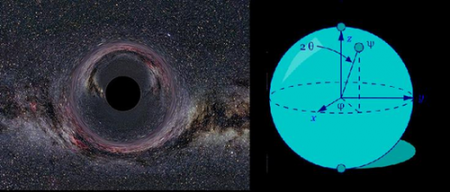July 3, 2008 feature
Qubits and Branes Share Surprising Features

What do black holes and entangled particles have in common? Until about a year ago, physicists thought that the two entities existed in completely separate worlds. Then, in 2007, physicist Michael Duff from Imperial College London demonstrated a correlation between the entanglement of three qubits and the entropy of a black hole. In the past year, several studies have demonstrated even more connections.
Most recently, Duff and colleagues from Imperial College London and the Institute for Research in Fundamental Sciences in Tehran, Iran, have discovered another correlation. They’ve shown that the “branes” in string theory mathematically correlate to the qubits in quantum information theory. Their study, titled “Wrapped Branes as Qubits,” is published in a recent issue of Physical Review Letters.
“These relations between black holes and qubits are still mysterious,” Duff told PhysOrg.com. “The significance of this recent paper is that, by invoking branes wrapping around the extra dimensions, it resolved the puzzle of why black holes should display any kind of two-valuedness: ‘To wrap or not to wrap; that is the qubit.’”
In string theory, which requires extra dimensions, branes are theoretical objects that can be used to describe parts of the universe on a quantum scale. For instance, black holes can be described by four D3-branes intersecting at an angle, which can be useful for understanding the microscopic origins of black hole entropy.
In the current study, the researchers have shown that four D3-branes can also be wrapped around the six extra dimensions of space (that exist in 10-dimensional string theory) in a way that closely resembles an entangled three-qubit state.
As the physicists explained, the way that each D3-brane can wrap one way or the other around dimensions resembles the two states that a qubit can have. The researchers showed that a similar correlation exists between M2-branes, which can wrap in one of three ways around dimensions, and qutrits, which have three possible states.
To mathematically demonstrate this connection, the physicists used a well-known fact from quantum information theory: a three-qubit state can be described by five parameters (four real numbers and an angle). They showed how these five parameters correspond to the four D3 branes and the branes’ angle of intersection.
The work adds to a growing body of papers published in the past year on correlations between entanglement and black holes (or quantum gravity). As the physicists described, these papers are building a kind of dictionary of translations between phenomena in one language to the phenomena in the other.
“When two very different areas of physics share the same mathematics, one can learn new things about each field by borrowing techniques from the other,” Duff said. “This has been a two-way pay-off and we are certain that yet more correlations will be discovered.”
However, no one yet knows whether there are any physical reasons underlying these mathematical coincidences. As Duff said, “an underlying physical basis, if it exists, would be an extra bonus.”
Still, understanding the mathematical correlations could be enough to lead to some interesting applications in quantum information theory.
“The weird kind of numbers known as octonions have fascinated both mathematicians and physicists for decades,” Duff said. “But in their recent books, both Roger Penrose and Ray Streater have written them off as ‘lost causes in physics' because they have so far failed to find any application. However, we believe that the tripartite entanglement of seven qubits (inspired by stringy black holes) provides a way of testing octonions in the laboratory, and this might find applications in QI, for example, in cryptography.”
More information: Borsten, L.; Dahanayake, D.; Duff, M. J.; Ebrahim, H.; and Rubens, W. “Wrapped Branes as Qubits.” Physical Review Letters 100, 251602 (2008).
Copyright 2008 PhysOrg.com.
All rights reserved. This material may not be published, broadcast, rewritten or redistributed in whole or part without the express written permission of PhysOrg.com.




















